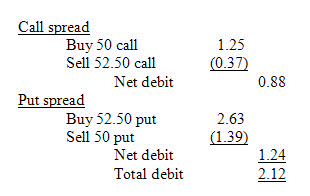A box spread is a complex option strategy that can “eliminate” risk and generate small returns, but understanding the key dangers and risk factors is crucial before trying this or any new option strategy.
Some option strategies are elegant in the sense that they create an exchange of profit potential and risk. If you are willing to accept a limited profit in exchange for eliminated risk, some spreads work well. However, these strategies also tend to be complicated, so you have to question whether entering them is worthwhile. One such example is the box spread.
Basic spreads include bull and bear versions. Either of these can consist of calls or puts. In a box spread, you combine bull and bear spreads to eliminate risk and create a form of option-based arbitrage. If the net cost/credit of the spread and the expiration profit both work in your favor, then you can create small profits from these positions.
One danger to the box spread is that in analyzing it, you can easily overlook the risk of early exercise. If the underlying stock moves significantly while the box spread is open, you need to understand the worst-case scenarios as well as the elegant best-case scenario you hope for in this position.
An example: On June 15, 2011, DuPont (DD) was selling close to $50 per share. At that time, July calls and puts were valued so that the following box spread could be opened:

For $212, you create a box spread, parts of which increase in value or decrease in value regardless of the direction of price movement in the underlying.
At any point above or below $50 per share, half of these positions will be in the money and the other half will be out of the money. Each will consist of one long and one short position.
If the price rises, profits build in the long call and the short put; if the price declines, profits build in the long put and the short call.
Elegant? Yes, this position is promising if you look only at profit potential. But both the short call and the short put present dangers.
This example involves options at the money (50) and with strikes above the money (52.50). A profit cushion can be built into a box spread when current price resides in between the strikes. For example, if the stock is currently at $35 per share and the box spread includes positions at $32.50 and $37.50, it may be more suitable. However, the proximity is only one factor in evaluating the box spread accurately. Of much greater concern is the exposure to short option expirations.
Traders are likely to believe they will close positions when they become profitable. That is the likely outcome, but what happens to the positions left open?
The long position is going to expire worthless, but the short position will be exercised or has to be closed at a loss or rolled forward. This is where the box spread becomes questionable.
Depending on how much movement you experience in the stock, you could end up with an exercise that eliminates any chance of profits. In the example, the net cost of the box spread was $212; but this is only the initial cost. The ultimate cost including losses upon exercise could be much higher.
The box spread works beautifully on paper. In reality, risk assessment is the key to understanding why complex strategies like this do not always work out profitably.
By Michael Thomsett
Michael C. Thomsett is an investment author with dozens of published books. His projects include the best-selling Getting Started in Options (John Wiley & Sons), currently in its eighth edition and with over 250,000 copies sold. This article originally appeared on Minyanville.com, a MoneyShow.com content partner.





















